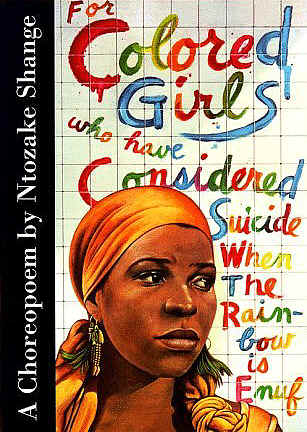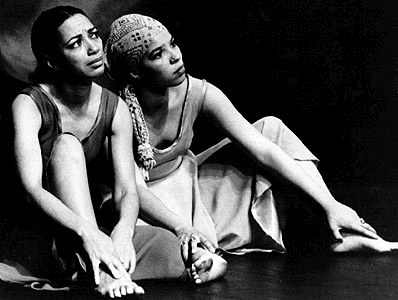|

The most vivid scene in Ntozake Shange’s novella
Sassafrass finds its heroine caught in the throes of writer’s block when suddenly, out of her closet, pops Billie Holiday:
& MULTITUDES OF BROWN-SKINNED DANCIN GIRLS WID OSTRICK FEATHER HEAD-PIECES & TAP SHOES STARTED DOIN THE CAKE WALK ALL ROUND SASSAFRASS, WHO WAS TRYIN TO FIGURE OUT THE PATTERNS ON THEIR EMBROIDERED DRESSES & TRYIN TO KEEP FROM JUMPIN UP & SHAKIN HER ASS WHEN IN UNISON THE ELABORATELY BEADED WOMEN STARTED SWINGIN THEIR HIPS TOWARD HER, SINGING
SASSAFRASS IS WHERE IT’S AT
This shake-and-fingerpop chorus line must never be far out of Ntozake Shange’s earshot. It seems omnipresent in
for colored girls who have considered suicide/when the rainbow is
enuf, an unusual dance/poetry/music work originally presented by the New York Shakespeare Festival at Joseph Papp’s Public Theatre complex. Recently,
for colored girls followed so many other Papp successes uptown to Broadway’s Lyceum Theatre.
The audience filters into the theater during a taped medley of songs that “colored girls” grew up with in the ‘60s, songs by Aretha Franklin, the Marvelettes, Carla Thomas, the Chiffons. As the lights begin a slow dim, the tape switches to a gaggle of giggling girls singing every Motown hit they can remember – not like hip brothers harmonizing on the street corners, but as if at a slumber party in the wee hours, half-remembering words and improvising clumsy harmonies.
In a flash these would-be Supremes are on stage, and a character called the Lady in Brown exhorts them, “Sing a black girls’ song – sing her song of life, she’s been dead so long!” They all clasp hands and dance in a circle, playing “Shake It Sally Walker.” From the loudspeakers burst Martha and the Vandellas, and the girls are all boogieing to the beat, singing along with “Dancin’ in the Streets” and collapsing on the floor to hear one another’s stories, the stories of seven colored girls before, but not beyond, considering suicide.

The music is an important set-up; it’s the unshakable common ground for the women in
for colored girls. “When You’re Young and In Love,” “I Never Loved a Man the Way I Love You,” “My Mama Said,” “B-A-B-Y” represent a coy, starry-eyed innocence that, like the pajama party ambience, diminishes as the play charts the disintegration of their Motown dreams into a dark reality that consists mostly of being abused, betrayed and otherwise ripped off by men. (Black men, of course. Shange’s play is quite uncompromisingly “for colored girls.” White men and women (girls) are treated only with cursory contempt.) From this point on, the only music consists of the occasional honking and blatting of Archie Shepp and other modern
jazzmen.
It’s hard to describe for colored girls so as to do justice to its passion. A bunch of black women sitting around bitching about their no-good men sounds distinctly unexciting. But Ntozake Shange is a poet who knows language as a fish knows water. Her words are layered with perception as well as complaint. Implicit in her anger is the knowledge that “I shoulda known better.” Her women are victims of rape, abortion, prostitution, violence, romanticism. “Heroically resisting being possessed,” they are not without their own weapons: music and dance (in a strange but effective style), their love for one another, and vindictiveness and manipulation.
now she stood a
reg’lar colored girl fulla the
same
malice/livid indifference as a
sistah
worn from supporting a wd-be
horn-player or
waitin by the window/
& they knew
& left in a hurry
she wd gather her tinsel
& jewels from the tub & laugh
gayly or vengeful/she stored her
silk roses by her bed & when she
finished writing the account
of her exploit
in a diary embroidered
with lilies & moonstones/she placed
the rose behind her ear
& cried herself to sleep.
Though Shange’s poems are sustained by their own colloquial vitality and potent imagery, the dramatic intensity of
for colored girls is drawn from the statuesque ensemble that embodies the poems. Possessing a raw performance energy entirely suited to the material, and the full authority of the feelings in the words, the cast radiates a jolting feminism.
for colored girls ends as it began – with music. But not a love-bitten tune with which Diana Ross might open at the Westchester Premier Theatre. Reveling in self-discovery, they trill gospel chords: “I Found God in Myself.”
Boston Phoenix, September 21, 1976
|